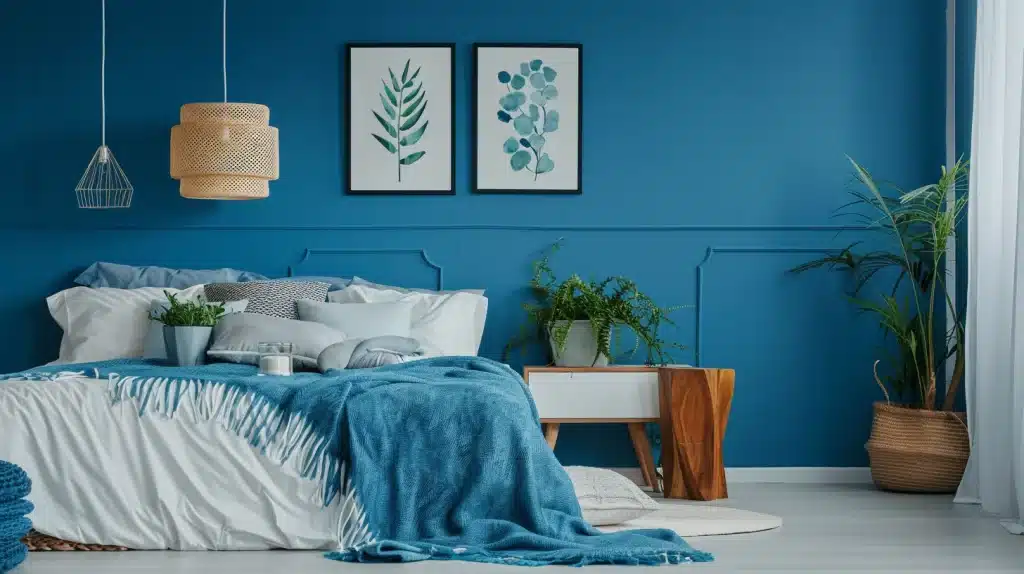
Creating a peaceful and inviting bedroom starts with choosing the right colours. The hues you surround yourself with can greatly influence your mood and sleep quality. Whether you’re looking to update your space or simply curious about the latest trends, understanding the psychology behind colour and how to incorporate it into your bedroom design can make all the difference in crafting a space that truly feels like home.
The Psychology of Colour in the Bedroom
Colour profoundly impacts our emotions and overall well-being, often influencing our mood in ways we might not even realise. In the context of a bedroom, where rest and relaxation are paramount, the choice of colour becomes even more significant.
Cool colours, such as blues, greens, and soft lavenders, are known for their soothing effects. These shades have been shown to reduce stress, lower heart rates, and even improve sleep quality by creating a tranquil environment. Blue, for example, is linked to calmness and stability, making it a natural fit for a space dedicated to rest. Similarly, green, often associated with nature, fosters a sense of balance and renewal, turning the bedroom into a sanctuary from the outside world.
On the other hand, warm colours like reds, oranges, and vibrant yellows can have a more stimulating effect. While these hues are great for energising communal spaces like kitchens or living rooms, they may disrupt the calm needed for a restful sleep if used excessively in the bedroom.
Red, often associated with passion and intensity, can inadvertently raise energy levels and tension, making it difficult to relax. Bright yellows, though cheerful, can be overly stimulating, leading to a restless atmosphere rather than a peaceful retreat.
Trending Bedroom Colours in 2025
There are plenty of popular colours trending for 2025 with Dulux choosing a versatile fresh hue with ‘Limitless’. Pantone’s ‘Peach Fuzz’ colour for 2025 also helps add warmth and cosiness to interior spaces.
This year’s bedroom colour trends are embracing a blend of serenity and sophistication with a focus on creating spaces that feel rejuvenating and effortlessly stylish. The spotlight is on a palette that combines earthy tones with soft, calming shades, reflecting a desire for interiors that promote well-being and comfort.
A prominent trend for 2025 is the incorporation of muted earth tones like warm taupes, soft browns, and clay-toned terracottas. These hues introduce a natural, grounding presence to the bedroom, enhancing the connection to the outdoors. Their subtle elegance offers versatility, seamlessly blending with a range of decor styles, from minimalist to rustic, while preserving a cosy and welcoming atmosphere.
In contrast, cooler hues like dusty blues and pale greens are also proving popular. These colours are prized for their calming effects which are perfect for a bedroom environment. Dusty blue, for instance, offers a fresh yet soothing atmosphere, helping to create a tranquil retreat ideal for unwinding. Pale green infuses the space with a touch of nature, fostering a serene environment that promotes relaxation.
Incorporating these trending colours into your space is not just about aesthetics; they also play a crucial role in enhancing the mood and ambience of your bedroom. Whether you’re looking to create a peaceful sanctuary with soothing blues and greens or prefer the cosy warmth of earthy tones, the right colour choice can transform your bedroom into a haven of relaxation.
Useful Tips For Incorporating Colour into Your Bedroom
Introducing colour into your bedroom can refresh the space and create the desired mood, whether you want a calm retreat or a lively atmosphere.
Find the Right Balance:
Finding the right balance when adding colour to your bedroom is essential to create a harmonious and inviting space. Too much colour can feel overwhelming, while too little might leave the room lacking personality and warmth. Consider the size of your room as a smaller room might benefit from lighter shades, while a larger space can handle deeper tones.
Consider your Natural Lighting:
Natural light can dramatically affect how colours appear in your home. With bright rooms, enhancing lighter shades will make them feel more vibrant, while darker rooms may benefit from deeper tones that add warmth and cosiness. Testing your chosen colours in different lighting throughout the day ensures they create the desired effect in your bedroom.
Use a Neutral Base:
Adding colour to a bedroom doesn’t always mean painting the whole room or even painting at all. Simply starting with a neutral base in your bedroom provides a versatile foundation to add colour in other ways. Neutrals create a calm and cohesive backdrop that makes it easier to add colour through bedding, artwork, or accessories. This approach also helps prevent the space from feeling too overwhelming, ensuring that any added colours stand out without clashing.








